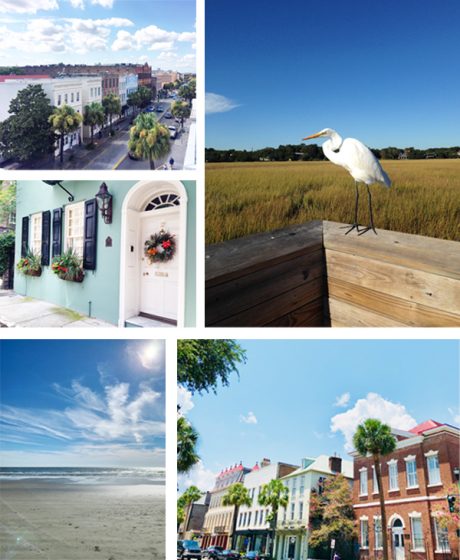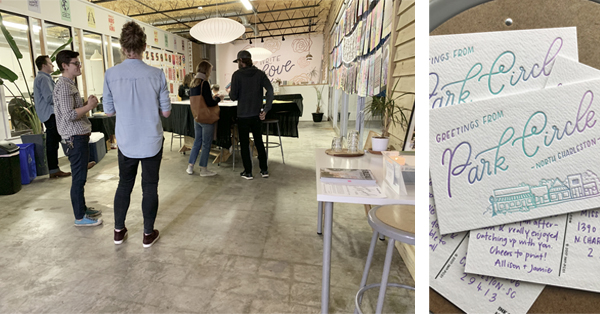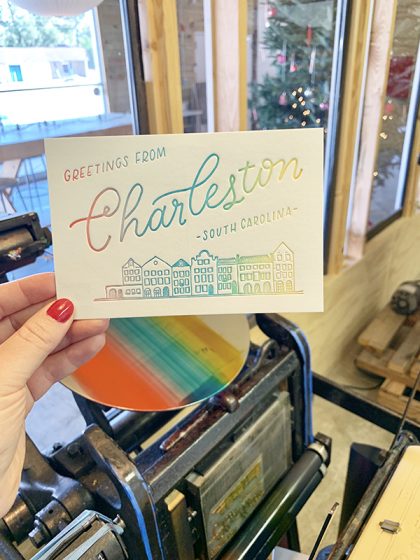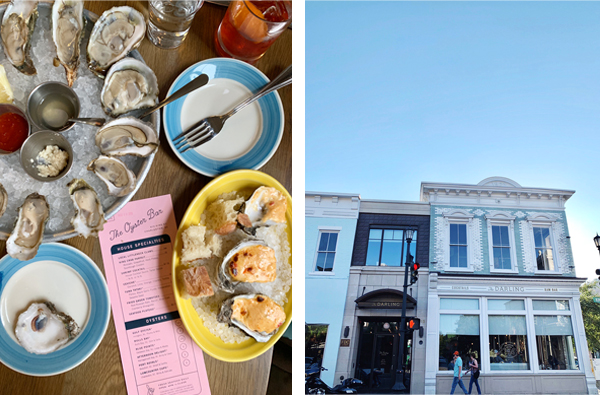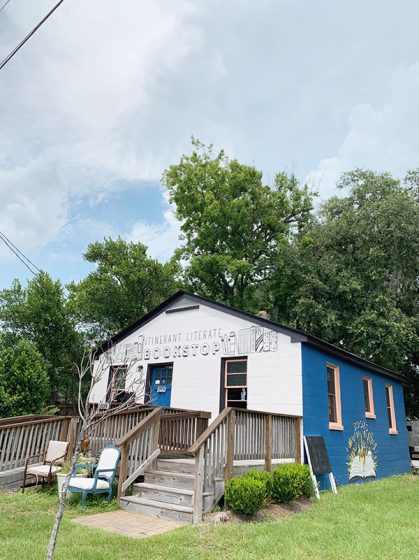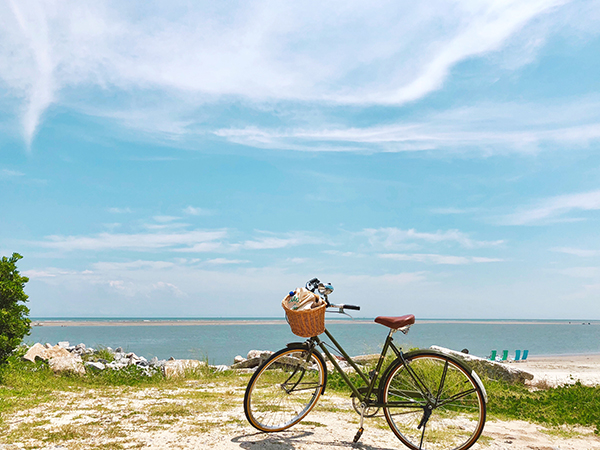L’Imprimerie Bâtard is a Northeastern France-based letterpress printshop that enjoys working with handset type and learning as much as they can. Pauline and Gaëtan work and breathe letterpress in their printshop where they blend old-world craftsmanship with a daring for experimenting.
(A note for our readers: This article appears in both English and French for all lovers of letterpress to read! The French translation appears in italics. Huge round of applause out to Pauline and Gaëtan for the French translations!)

PRINTING IN FRANCE L’Imprimerie Bâtard -literally The Bastard Printer’s- is a new design and printing workshop in Nancy, France run by Pauline (24 yo) and Gaëtan (35 yo). We are hosted by a youth and cultural center called la MJC Lillebonne, which is super cool because it makes our everyday life at work very lively.
L’Imprimerie Bâtard -littéralement Bastard Printer’s- est un tout nouvel atelier de design et d’impression à Nancy en France géré par deux personnes : Pauline (24 ans) et Gaëtan (35 ans). Nous sommes hébergés dans une Maison de la Jeunesse et de la Culture, la MJC Lillebonne, un lieu super cool qui met plein de vie dans notre quotidien.

LETTERPRESS BEGINNINGS Pauline discovered letterpress during her fine arts studies, which she completed last year. Her school had a letterpress workshop led by a specialized teacher so she had the opportunity to learn the basics of the letterpress technique in different contexts such as personal editorial works or workshops that her teachers used to organize.
Gaëtan founded a nonprofit publishing house several years ago so he already knew a bit about graphic design and printing. He first practiced letterpress at his friends’ printshop. They had organized a week to produce a gazette combining text and illustration only printed by hand. They had invited other typographers so this first approach of letterpress revealed to be very enriching to him.
Pauline a découvert la typographie manuelle lors de ses études aux Beaux-Arts, qui se sont terminées l’année dernière. Dans son école, il y avait un atelier géré par un professeur spécialisé, elle a donc pu apprendre les bases de la technique dans différents contextes : des projets éditoriaux personnels ou encore des ateliers organisés par les professeurs.
Gaëtan, lui, a fondé une maison d’édition associative il y a plusieurs années, il avait donc déjà été au contact de l’univers du graphisme et de l’impression. Il a pratiqué la typographie pour la première fois dans l’imprimerie d’amis à lui. Ils avaient organisé une semaine pour créer une gazette mélant texte et illustration complètement imprimée à la main. Ils avaient invité d’autres typographes, cette première approche a donc été très riche en découvertes et en apprentissages.

THE PRINTSHOP One of our favorite things about our workshop is also one of the things we hate the most: it is very small. When people visit us, we like to tell them that we have the smallest printing atelier in the world. On the one hand, it makes the atmosphere warm and cozy. The office part, with its old desk and granny carpet, definitely makes us feel at home. On the other hand, a so small working place requires loads of tricks to optimize the storage of our tools and equipment.
Une des choses que nous préférons à propos de notre imprimerie est également une des choses que nous détestons le plus : elle est très petite. Quand nous faisons des visites, nous nous amusons à dire que c’est la plus petite imprimerie du monde. D’un côté, ça donne une ambiance chaleureuse, cosy. On s’y sent à la maison, surtout dans la partie bureau où il y a une vieille table et un vieux tapis. D’un autre côté, une si petite surface de travail nous oblige à redoubler d’inventivité pour optimiser le rangement de notre matériel.
HISTORIC NEIGHBORHOOD Absolutely. The cultural center accommodating us is based in an old private hotel built during the Renaissance, so the place is very picturesque. Another cool thing about this center is that it is so huge that it has many different arts and crafts workshops, such as engraving, bookbinding, drawing, silkscreen printing, pottery, sculpture.

We are surrounded by many interesting practices and crafts. Also, the whole neighborhood is the oldest part of the city and certainly one of its most beautiful areas. It covers many wonderful Renaissance landmarks, like a Gothic church, a ducal palace turned into a museum and ancient city gates.

Tout à fait. La MJC qui nous loge est basée dans un ancien hôtel particulier construit à la Renaissance, le bâtiment est donc très pittoresque. Ce qui est aussi génial dans le fait d’être hébergés dans une MJC aussi grande, c’est la quantité et la diversité des ateliers d’artisanat qui y sont proposés : gravure, reliure, dessin, sérigraphie, poterie, sculpture… Nous sommes entourés de pratiques et de savoirs tous plus intéressants les uns que les autres. Au delà du bâtiment en lui-même, le quartier entier est une des plus anciennes parties de la ville et sans doute une des plus belles. Il comprend de nombreux monuments datant de la Renaissance, comme une église gothique, un palais ducal transformé en musée, ainsi que les anciennes portes de la ville.
PRINTING MENTORS Our inspirations are diverse and come from different movements: absurdism and Oulipo (a French movement about constrained writing) for the writing of the texts, and some graphic designers who played with letterpress such as Robert Massin and Jan Tschichold for the design part of our work. We wouldn’t say that we have specific “mentors” but we had the opportunity to meet some old printers and typographers who learned letterpress as a craft and they gave us some advice. We also usually save good printing ideas we find on the internet, mostly on Instagram, and try to reuse them in our work.

Nos inspirations sont variées et nous viennent de différents mouvements: l’absurde et l’Oulipo (un mouvement français d’écriture sous contrainte) en ce qui concerne l’écriture des textes, et plusieurs graphistes ayant joué avec la typographie comme Robert Massin et Jan Tschichold pour la partie création de notre travail. Nous ne pourrions pas nommer de réels “mentors” mais notre travail se base à la fois sur les bonnes idées que nous trouvons sur internet, notamment sur Instagram, et sur les précieux conseils des quelques imprimeurs typographes dont c’est le métier que nous avons eu la chance de rencontrer.
FULL TIME FUN Yes, we do [full time] ! It’s been 6 months since our atelier was set up. At the beginning, we wanted to do it as a pass-time in our garden shed, but when we had the opportunity to buy our press and our first cases, it became obvious for us that we would make it our new job.
Oui ! Ça fait 6 mois que notre atelier est installé. Au début, nous voulions faire de la typographie un passe-temps et occuper l’atelier au fond de notre jardin, mais quand nous avons eu l’occasion d’acheter notre presse et nos premières casses, ça nous est paru évident que nous en ferions notre nouveau métier.
DESIGNING A CUSTOM PIECE. The first step of our design process is the phase of creation, which includes the writing of the texts and the making of the illustrations (we mainly use linocut). Then, we compose the texts we wrote, testing different types: metal types for the body of the text and wood types for the titles. We’ll try (as much as possible) to avoid using plates and linotype to keep our work the more handmade. After choosing the most coherent characters in relation to the project, we print the texts and illustrations on transparent plastic paper on our proof press so that we can modulate the elements and decide on the final layout. We got this trick from our friend Guillaume Guilpart, who is a typographer at a workshop called Paris Print Club. We also take advantage of this step to do an orthotypographic correction of the texts. We make the color and paper choices and finally we can print on our bigger press.

La première étape de notre processus de design est la phase de création, c’est-à-dire l’écriture des textes et la réalisation des illustrations (nous utilisons avant tout la gravure sur lino). Ensuite, nous composons les textes en testant plusieurs typographies : les caractères plomb pour le labeur (autrement dit le corps de texte) et des caractères en bois pour les titres. Nous essayerons au maximum de nous passer de clichés et de linotypie afin de conserver l’idée d’artisanat. Après avoir choisi les typographies les plus cohérentes avec le projet, nous imprimons les textes et les illustrations sur du papier rhodoïd sur notre presse à épreuve afin de pouvoir agencer les éléments entre eux et décider de la mise en page finale. Cette astuce nous a été donnée par Guillaume Guilpart, un ami typographe à l’atelier Paris Print Club. Nous profitons également de cette étape pour faire la correction orthotypographique des textes. Nous faisons un choix de couleurs et de papier et nous pouvons finalement imprimer sur notre plus grosse presse.
PRINTING FEATS Above all, we are proud of our atelier. Just one year ago, we had no idea that it would be so thriving and fulfilling today, that we would have so many tools and materials to work with. It has been a lot of work and we’re still motivated to make this place more enjoyable and more practical. We also consider all the knowledge we got these past months just by practicing our passion and by meeting people with whom we share that passion as a big accomplishment. We can almost say that we are self-made typographers and that definitely rocks.

Moreover, this past year, we had the time to work on two big creations that we would like to point out. First, we designed a numerical font using the software Glyphs (and the precious help of a type designer friend) and we made a wood type of it using a laser printer. We called it “la typo bâtard” (“the bastard font”) in reference to our printer’s name. The second work we’d like to talk about is a poster we did for “la Fête de l’Estampe” (the National Print Day). It is composed by two prints of wood planks, a long text in two columns above these prints, which is the page of the dictionary that contains the word bâtard (bastard), and an extract of this page as a title covering a bit of the text and printed with wood types.
Nous sommes avant tout fièr·e·s de notre atelier. Il y a tout juste un an, on ne s’imaginait pas que tout s’y passerait aussi bien aujourd’hui, qu’on aurait autant d’outils, de matériel de travail et d’opportunités. Ça a été beaucoup de boulot mais nous sommes toujours aussi motivés à rendre cet endroit le plus agréable et le plus pratique possible. Nous considérons également comme un accomplissement tout le savoir que nous avons acquis ces derniers mois simplement en cultivant notre passion et en rencontrant des personnes avec qui partager cette passion. Nous pouvons presque dire que nous sommes des self-made typographes et c’est trop cool.

En plus de ça, cette année, nous avons passé beaucoup de temps sur deux créations en particulier dont nous aimerions parler. D’abord, nous avons dessiné une police de caractères numérique sur le logiciel Glyphs (et grâce à la précieuse aide d’un ami dessinateur de caractères) et nous en avons fait une série de caractères en bois avec une graveuse laser. Nous l’avons appelée « la typo bâtard » en référence au nom de notre imprimerie. Le second travail dont nous aimerions vous parler est une affiche que nous avons réalisée pour la Fête de l’Estampe. Elle est composée de deux empreintes de morceaux de bois, d’un long texte en deux colonnes sur ces empreintes, qui reprend la page du dictionnaire qui contient le mot « bâtard », et un extrait de cette page comme titre, qui couvre une partie du labeur et imprimé avec des caractères bois.
PRESS HISTORY Our first press is a big red flatbed cylinder press, a Korrex press manufactured by Simmel in 1969. This specific model is called “Berlin”. But we mostly call it by its pet name: Simone.

Notre toute première presse est une grosse presse rouge à cylindre, une Korrex fabriquée par Simmel en 1969. Ce modèle s’appelle « Berlin ». Mais nous l’appelons principalement par son petit surnom : Simone.

BOXCAR’S ROLE We’re grateful to Boxcar Press for their interest in our little printing house. We were glad to see that the passion for letterpress could cross the borders between different countries. It was a pleasure to read their blog and discover so many other printers and their techniques. They provide a really extensive and necessary work of investigation about letterpress. As far as we’re concerned, their questions enabled us to look back at the past year and to realize what we have achieved until now. So we can thank them for the dissemination of this article about us and for letting us translate it to share it with our French community.
Nous sommes reconnaissant pour l’intérêt qu’a porté Boxcar Press à notre petite imprimerie. Nous étions enchanté·e·s de voir que la passion pour l’impression typographique pouvait traverser les frontières. Ça a été un plaisir pour nous de lire leur blog et de découvrir autant d’autres imprimeurs ainsi que leurs techniques. Ils proposent un travail d’investigation du monde de la typographie vraiment complet et nécessaire. En ce qui nous concerne, nous avons pu, en répondant à leurs questions, faire le bilan de notre année passée et nous rendre compte que tout ce que nous avions accompli jusqu’à maintenant. Nous pouvons donc les remercier pour la diffusion de cet article et pour nous avoir permis de le traduire afin de le partager avec notre communauté en France.
PRINTING TIPS The most important advice that we could give is to try things. Letterpress is an open door to a world of creation with a lot of variables: characters, colors, shapes, layouts. They are some fundamental rules to respect such as the type height, but once you’re sure about these basics, you’re completely able to explore, imagine, make, invent new things. That was the case when we had the idea to print pallet planks to draw the shape of columns in the background of our poster… After all, why not?

Le conseil le plus important que nous pourrions donner est d’essayer des choses. La typographie est une porte ouverte à un monde de création avec des tas de variables : les caractères, les couleurs, les formes, les mises en page… Il y a certaines règles fondamentales à respecter, comme la hauteur typo, mais une fois les bases intégrées, on peut complètement se permettre d’explorer, d’imaginer, de fabriquer et d’inventer de nouvelles choses. Ça a été notre cas quand nous avons eu l’idée d’imprimer des planches de palettes pour dessiner la forme de colonnes en arrière plan de notre affiche. Après tout, pourquoi pas ?
WHAT’S COMING NEXT Our main plan for the upcoming year is to open our atelier to people and to give letterpress lessons. Starting from January 2020, we’ll give a three-hour lesson twice a week. In addition to that, we’ll try to organize workshops over one or several days in our atelier, sometimes soliciting the other arts and crafts workshops of our big house in order to provide an overview of the process for making a real printed object by hand. We would also like to offer classes outside our workshop, in other cultural or specialized structures such as schools, with our little proof press and some previously selected characters. We are absolutely willing to share our know-how, especially from the perspective of doing popular education.

Notre principal projet pour l’année qui arrive est d’ouvrir notre atelier aux gens et de donner des cours de typographie. À partir de janvier 2020, nous donnerons des cours de trois heures deux fois par semaine. En plus de ça, nous essayerons d’organiser des ateliers sur un ou plusieurs jours dans notre imprimerie, parfois en sollicitant les autres ateliers d’artisanat de notre grande maison afin de donner un aperçu du processus de fabrication d’un vrai objet imprimé à la main. Nous aimerions aussi proposer des ateliers en dehors de notre imprimerie, dans d’autres structures culturelles ou spécialisées comme des écoles, avec notre petite presse à épreuve et quelques caractères préalablement sélectionnés. Nous sommes complètement partant·e·s pour partager notre savoir-faire, notamment dans une optique d’éducation populaire.



















